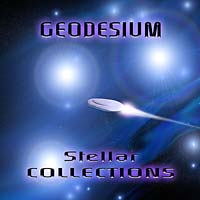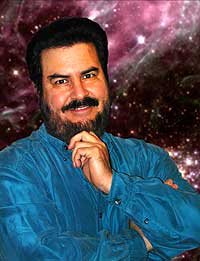Stellar Collections
Soar through space and time on Mark's audio starship!
Sunrise over an ancient earthen pyramid, visits to gas giant planets, exploring the sands of Mars, and interstellar journeys through the galaxy — these are a continuation of the odyssey on which space music composer Mark C. Petersen has been conducting for his listeners for nearly 25 years. They are waypoints on the flight path of his audio starship, and describe incredible sojourns beyond the Earth — aural voyages to infinity. Devotees of space music have a new collection of planetarium soundtrack works by Mark C. Petersen to savor, on an hour-long retrospective CD album, titled Stellar Collections.
In Stellar Collections, Mark has arranged various "suites" from the best of his planetarium soundtrack work over the last two decades. It is a compilation of 26 space music compositions created between 1985 and 2001, work the composer says continues his use of music to explore the depths of space. "In the creation of space music for planetarium shows, I get to take audiences from the planetarium dome to anywhere in the universe they want to explore. By extension, in releasing this soundtrack music CD, I can speak directly to listeners, and take them from my studio to the stars," he said.
The planetarium is the major medium he has composed for since 1975, and according to Petersen, it inspires much of his work. "I create music as a major part of the audio-visual experience of the modern planetarium show. It complements and enhances the immersive environment we encounter under the dome."
Geodesium (pronounced Gee-oh-DEE-zee-um) is a blending of the words "geodesic dome" and "planetarium", and it's become the nom-de-plume for Mark's space music. Stellar Collections is the sixth release in the series. As with the previous albums, much of his music comes from the rarefied domain of planetarium programs, underlying and interacting with narratives. Removed from this context in album form, the music comes to the forefront, allowing the listener to appreciate its rhythms and graceful melodies on their own.
The music on Stellar Collections spans a 16-year period in Mark's composition career. While avid Geodesium fans may recognize a few familiar themes among the works comprising this retrospective, this is not a "Geodesium's greatest hits" compilation; all 26 selections are new recordings previously unreleased in to the general public.
All the pieces evoke images of space and space travel, but they have transcended the cliches of early space music. One enthusiast has described the Geodesium sound as "space music with hooks."
Stellar Collections opens with Winter Sunrise a piece that represents a musical and technological watershed event in Mark's compositional life. Prior to its creation, Mark's musical tools were relatively simple analog synthesizers and an electric piano, and he used them to compose in a more electronic-music style — a direction most evident on his first two albums, GEODESIUM and Double Eclipse. These early albums feature a mix of original electronic music with transcriptions and synthesizer multitrack realizations of classical band, orchestra, and organ scores. Mark created Winter Sunrise in 1985, using what was then a newly-released digital sampling keyboard, the E-mu Systems Emulator II. With the introduction of the Emulator, Mark was free to incorporate the universe of sampled sounds into his space music. At this point, he began to concentrate on original works for his exploration of the space music genre, leaving behind the transcriptions of his musical youth.
The Emulator technology effected a change in the Geodesium sound, and Winter Sunrise became the first of a series of works that define what is now familiar to listeners as the Geodesium trademark style of space music. It was originally composed as the opening music to a show called Gateway to Infinity, created by Loch Ness Productions in 1985 for the grand re-opening of the St. Louis Science Center's McDonnell Space Theater. Like the planetarium show, which began on the windswept prairies and quickly moved to the deep realms of space, primitive flute melodies evolve to a full orchestral sound and onto the ethereal strains that denote "space". According to Mark, Winter Sunrise also provides a musical bridge of sorts from the last album Anasazi released in 1993. "It could be there are some people following the development of Geodesium albums in chronological order. Well, Anasazi left our listeners at the dawn of the second millennium in Chaco Canyon and at the Mayan pyramids. It was a long 8-year wait for this album to come out, so we needed to "ease" them out of the old and into the new millennium. Gee, a thousand years — in just two and half minutes!" Mark laughed.
The Andromeda Collection has several tracks that were composed for the 1997 planetarium show Light Years From Andromeda. They are called Further Back in Time, Stellar Collections, and The Enormity of Distances and showcase how Mark's space music developed a more mature, refined and polished sound over the years.
The third track, Perceptions, was composed in 1995 as exit music for a planetarium show produced for the Taylor Planetarium at the Museum of the Rockies in Bozeman, Montana. It's an up-tempo "space cruiser" piece, featuring another of Mark's trademark sound groupings: a sequencer bass, overlaid by shimmering melodies and effects. "Not everything in space is the floating-in-limbo stuff," Mark pointed out. "You have to rock out once in a while!"
Following that is a suite of music originally composed for the 1989 Loch Ness Productions program The Voyager Encounters. The pieces Jovian Moons, Traveler's Tales, and Great Red Spot are intended to convey the sense of wonder and awe an observer would feel in visiting the planets of the outer solar system. Also in this collection, Mark revisits a piece originally released on Anasazi as Chetro Ketl. For the planetarium show, he enriched its haunting and grandly sweeping melody with additional tracks of voices and percussion, and spread the music out through the stereo field, giving the listener a more satisfying experience for their aural visit to the largest storm on Neptune called "Great Dark Spot."
Mark then continues his musical exploration of the solar system in The Distant Worlds Collection. These pieces were originally composed to accompany planetarium special effects scenes produced on video by Sky-Skan, Inc. of Nashua, New Hampshire. Each musical suite encapsulates the eerie and alien planet scenes and moonscapes depicted in the video: Pluto's companion Charon, Jupiter's icebound moon Europa, the mottled Uranian moon Miranda, Neptune's frozen Triton, and the huge Caloris Basin on the planet Mercury.
Laser Bounce is another composition created for Light Years From Andromeda, depicting bouncing laser pulses between Earth and the Moon. It provides a sort of light-hearted frolic, with analog sounds more reminiscent of Mark's earlier electronic music compositions.
The final suite on the album, The MarsQuest Collection is the longest, and the eleven selections include Mark's most recent work: Mariner, Pathfinder, Between Planets, Antarctica, and Life Rock were all recorded in 2001. The other tracks come from music originally composed for Loch Ness Productions' popular presentation The Mars Show — now re-written and re-released as MarsQuest.
Three of the pieces in this suite will be familiar to fans of the album Fourth Universe. This time around, Martian Mysteries, On Orbit, and Red Planet Rhapsody have been re-recorded, with additional tracks and deeper stereo fields for a more satisfying "headphone listen." The plaintive melody and winds in the last moments of the extended last track close out this album in a similar manner to Fourth Universe — with a sense of the magnificent desolation of the surface of the Red Planet.
The soaring aural visions of the universe in Stellar Collections will appeal to those who watch the skies and wonder. In the end, the compositions on this CD will give everyone a chance to explore the mysteries of space with music that works on many diverse and cosmic scales.




